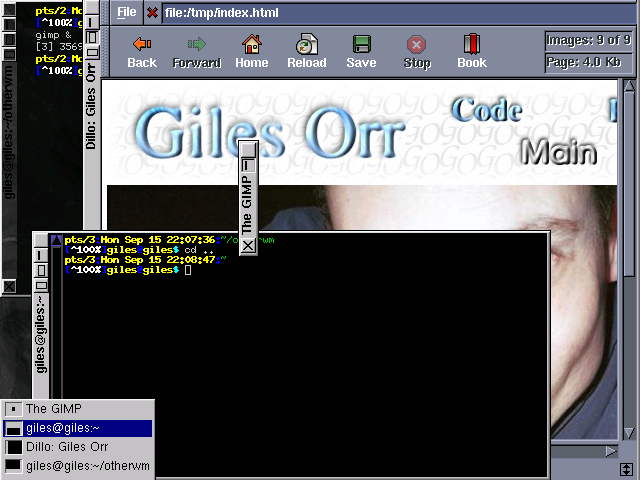FLWM
FLWM
- Image

FLWM's most distinguishing feature is its vertical titlebars. Recently it's also become known to me for the odd behaviour of aterm (the titlebar goes transparent - note the window in the upper left). The menu of windows in the current frame is in the lower left corner.
- URL
- Version
I used 1.00, and that appears to be the most recent version. It dates from September 2000.
- Documentation
One man page, which is short but covers pretty much everything you need to know.
- Themes
No.
- Discussion
FLWM is built on the WM2 code (thus the sideways titlebars) and uses the "Fast Light Tool Kit" (FLTK). No development appears to have been done on it for about three years. Too bad, because I really enjoyed using this one. It's ugly, but it's very well thought out and easy to use.
The biggest oddity I had using this was its treatment of my preferred term, "aterm." I use aterm because it allows better pseudo-transparency than rxvt (which it's based on) but isn't nearly as much of a hassle to set up as Eterm, the only other thing that comes close on transparency. Apparently something about FLWM gets confused and extends the transparency to the aterm titlebar. It makes it pretty hard to read unless you have a very light background - it's also difficult to make out your buttons.
FLWM starts with only one workspace (and doesn't use virtual desktops). You create and name your own desktops as you go. The menu is accessed by any kind of click on the desktop. The menu lists your existing desktops (submenus of each list the windows there), a "New Desktop" option, a "Logout" option, and the contents of your ~/.wmx/ directory. The latter is how WMX handles its menuing system. It's simple, but works fairly well. Other desktops are reached through the menu, or with Ctrl-FnKey to switch to desktop N. The manual page claims that Ctrl-Tab will cycle desktops, but the binary I retrieved from the author's website doesn't appear to support that. One nice touch of the menu is that each window is indicated by a block in a square indicating the window's relative position on its desktop. This acts fairly well as a mnemonic. Focus style is SloppyFocus. A mouse click only raises the window if it's on the frame or titlebar.
While FLWM does have a way to make windows sticky, it doesn't have a way for something like xmms or a clock to be made automatically sticky. A minor annoyance.
I really liked this WM. I liked the defaults and it's easy to understand and get going. Ultimately I was a little unhappy with the appearance and the lack of configurability, but I wouldn't be upset if I was stuck in this WM.
- Pros
Extremely lightweight. Well thought out buttons. Vertical titlebars are small and use real estate well. Fairly elegant.
- Cons
No themes, no way to change appearance at all. Handles aterm oddly. Very limited configurability.
- Community
No.